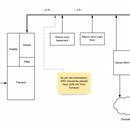How far from the furnace can I put an ERV unit?
Hi,
I just bought a Vanee 60H+ ERV and I am planning out my “simplified” install. The unit will basically connect to the return duct, and will interlock with the furnace fan.
I’ve read in the documentation and in numerous other articles that the *minimum* distance in linear feet should be 10 from the furnace. But what is the maximum? Is there a maximum?
I have a place, about 25 linear feet downstream from the furnace where it’s convenient to place the unit. Easy access to outside wall, lots of space, etc.
Is 25 feet too far? Will the furnace fan not be able to “pull” the fresh air from ERV down towards the furnace? Will the air simply go back to the ERV since the ERV fan is stronger (due to the fact it’s closer)?
I will also be “skipping” several branches of the return duct since the unit will be placed so far down the trunk. Is that an issue?
I’m planning to feed (as per the simplified install method) both the fresh air and the stale air lines from the ERV to the return duct, spacing them out about 4ft.
Thanks!!
GBA Detail Library
A collection of one thousand construction details organized by climate and house part










Replies
This seems like a question for the manufacturer. Have you contacted its support team?
For this type of install the furnace fan has nothing to do with it. As long as the ERV's fans can handle the duct length, it should work. The specs say it uses 5" duct and tops out at 133 cfm. For a 25' run, I'd go up to 6" duct to keep the pressure losses down. That shouldn't be any problem for the ERV fans.
Note that this kind of installation really only gives you fresh air when the furnace fan is running - and that's really not all that often on most days. An install where return is pulled directly from bathrooms etc, and the ERV run continuously, would give you better overall air quality - but there are probably things about this installation I'm not aware of...
@Cramer
Thank you for the reply.
I've already installed 5 inch vent hoods and made 5" holes in the brick. Don't want to go back and redo. If I connect 6" ducts to the 5" vents would that be better than the 5" ducts?
As far as stand along system: My problem is if it's -20C outside and say 21C inside, and the unit's recovery rate is not 100%, I don't want to be blowing cooler into any living spaces otherwise you'll feel as if there is a draft. I would rather the furnace warm it up before introducing it into the household.
I also find in the winter (I live close to Toronto) and in the summer the system (AC or heat) does activate often. I'm thinking I'll configure the ERV to run for 20 mins every hour, on low. If the ERV "piggy backs" on the existing running of the fan (due to AC or heat coming on) then I'm not really adding additional blower run time.
I'm trying to understand the spec sheet, it seems at -25C and at 49CFM, the "sensible recovery efficiency" is at 60%. So that means if it's 21C indoors I will get 12.6C coming in?
Spec sheet: https://www.vanee.ca/DATA/DOCUMENT/91_en~v~spec-sheet-60h-erv.pdf
The best compromise when installing into existing systems is a hybrid ducting, lastl system configuration shown here:
https://www.finehomebuilding.com/2014/11/05/ducting-hrvs-and-ervs
This way if the hvac is running, you get automatic tampering of the incoming air, but when it is not running, you can still get ventilation without needing to run your furnace fan. You can still run the furnace fan if you want but depending on the blower type, that could add a fair bit of power use.
This does mean running a couple of stale air pickups to your bedrooms. These can be done relatively easily if you go with 3" semi rigid aluminum ducting (dryer went stuff but smaller) as it can be fished inside a 2x4 wall.
The air will be colder than that, the equation is:
(HRV effectiveness/100) (T3-T1) + T1 = T2
Where T1 = Outdoor design temperature (Cold air intake)
T2 = Air delivered by HRV ( Fresh air supply)
T3 = Indoor design temperature (Warm stale air)
@Akos Thanks for the link and the equation.
As per the link, running the ERV w/o interlocking the furnace can be an issue -- "...are particularly hard to balance because there are two different fan conditions: when the furnace fan is operating and when it isn’t".
So I will interlock. I'll take a look at the balanced approach though. Looks like it's not too difficult to do. Thanks!